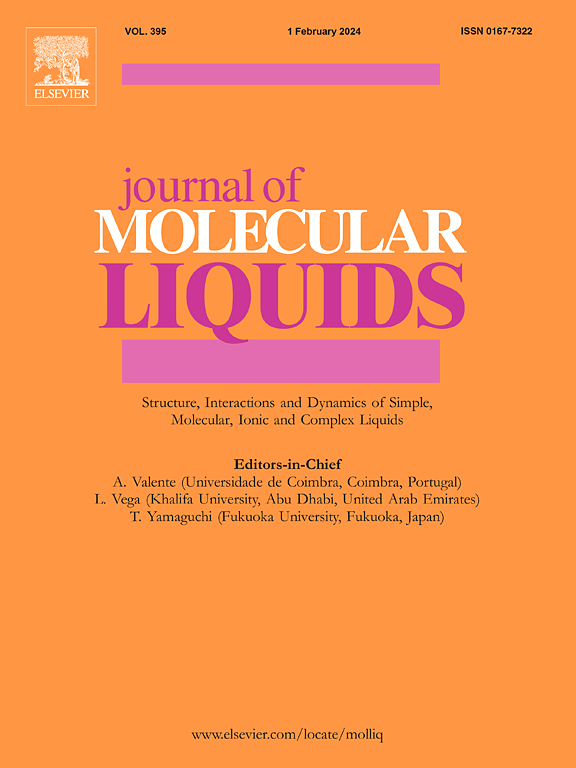用于环境修复的深共晶溶剂型纳米材料合成研究进展
IF 5.3
2区 化学
Q2 CHEMISTRY, PHYSICAL
引用次数: 0
摘要
近来,生态友好型深共晶溶剂(DES)在吸附材料的功能化和合成中的应用获得了极大的研究兴趣。这些材料主要通过降解或吸附来处理污染水体,正在成为传统技术的可持续替代品。然而,有关使用 DES 功能化和合成吸附材料的信息却散见于各种文献中。本综述旨在整合和澄清有关基于 DES 的吸附剂的合成和功能化、其作为纳米材料在水处理中的应用以及此类技术的未来前景的大量信息。在吸附剂的改性和功能化方面,DES 具有毒性低、成本效益高和环境友好等优点,是传统溶剂的理想替代品。大多数 DES 能有效地引入所需的功能性并提高吸附剂的表面积,从而大大提高对污染物的去除率。本综述汇编了有关合成和改性石墨烯氧化物、碳纳米管、金属氧化物及其他材料用于降解/吸附药物、除草剂、染料、农药、重金属离子及其他水污染物的最新文献。除此之外,基于 DES 的纳米材料未来还可能应用于纳米技术、纳米流体、纳米催化剂、生物传感器、环境修复等领域。预计这些领域将呈指数级增长,因此迫切需要进行此类审查。本文章由计算机程序翻译,如有差异,请以英文原文为准。

Advances in deep eutectic Solvent-Based synthesis of nanomaterials for environmental remediation
The application of eco-friendly deep eutectic solvents (DES) in the functionalization and synthesis of adsorbent materials has gained significant research interest in recent times. These materials, employed for treating polluted water primarily through degradation or adsorption, are emerging as sustainable alternatives to traditional technologies. However, the information regarding the functionalization and synthesis of adsorbent materials using DES is dispersed throughout the literature. This review aims to consolidate and clarify the extensive information available on the synthesis and functionalization of DES-based adsorbents, their application in water treatment as nanomaterials, and the future prospects of such technologies. DES presents an ideal alternative to conventional solvents for modifying and functionalizing adsorbents due to their lower toxicity, cost-effectiveness, and environmental friendliness. Most DESs effectively introduce desired functionalities and enhance the surface area of adsorbents, thereby greatly enhancing the removal of pollutants. This review compiles recent literature on the synthesis and modification of graphene oxides, carbon nanotubes, metal oxides, and other materials for the degradation/adsorption of pharmaceuticals, herbicides, dyes, pesticides, heavy metal ions, and other water contaminants. Besides this, DES-based nanomaterials have potential future applications in nanotechnology, nanofluids, nanocatalysts, biosensors, environmental remediation, among others. The anticipated exponential growth in these areas underscores the urgent need for such a review.
求助全文
通过发布文献求助,成功后即可免费获取论文全文。
去求助
来源期刊

Journal of Molecular Liquids
化学-物理:原子、分子和化学物理
CiteScore
10.30
自引率
16.70%
发文量
2597
审稿时长
78 days
期刊介绍:
The journal includes papers in the following areas:
– Simple organic liquids and mixtures
– Ionic liquids
– Surfactant solutions (including micelles and vesicles) and liquid interfaces
– Colloidal solutions and nanoparticles
– Thermotropic and lyotropic liquid crystals
– Ferrofluids
– Water, aqueous solutions and other hydrogen-bonded liquids
– Lubricants, polymer solutions and melts
– Molten metals and salts
– Phase transitions and critical phenomena in liquids and confined fluids
– Self assembly in complex liquids.– Biomolecules in solution
The emphasis is on the molecular (or microscopic) understanding of particular liquids or liquid systems, especially concerning structure, dynamics and intermolecular forces. The experimental techniques used may include:
– Conventional spectroscopy (mid-IR and far-IR, Raman, NMR, etc.)
– Non-linear optics and time resolved spectroscopy (psec, fsec, asec, ISRS, etc.)
– Light scattering (Rayleigh, Brillouin, PCS, etc.)
– Dielectric relaxation
– X-ray and neutron scattering and diffraction.
Experimental studies, computer simulations (MD or MC) and analytical theory will be considered for publication; papers just reporting experimental results that do not contribute to the understanding of the fundamentals of molecular and ionic liquids will not be accepted. Only papers of a non-routine nature and advancing the field will be considered for publication.
 求助内容:
求助内容: 应助结果提醒方式:
应助结果提醒方式:


